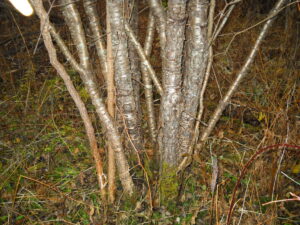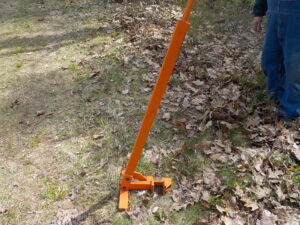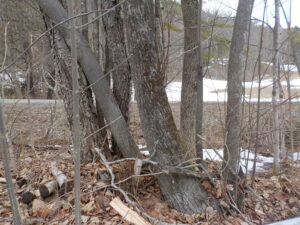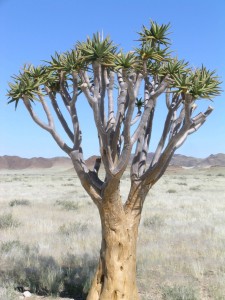Early Spring Chores
If you have a wooded area on your property, it probably needs some help from you, especially if you haven’t done any thinning or grooming of trees in recent years. Start by going outside and really look at the trees growing on your property with a critical eye.
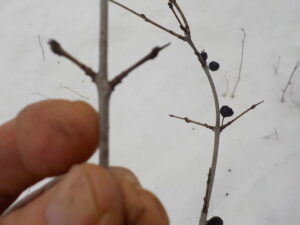
Buckthorns still have black berries and small branches that are sub-opposite (see pair just above my finger) or opposite each other.
Trees that I cull from my woods include poplars (Populus spp.), boxelder (Acer negundo) and alders (Alnus spp.). These are fast-growing trees that are short-lived and that produce lots of seedlings.
To rid your property of buckthorns, you can pull young ones or girdle the older ones. Trees up to about 2.5 inches in diameter can be pulled with a tool designed for that purpose. It is often called a weed wrench, although the original Weed Wrench company has gone out if business. Another brand of weed wrench is called the “Pullerbear”. It is a steel tool with a gripping mouthpiece and a long handle that provides mechanical advantage. They come in several sizes and prices. For more info see www.pullerbear.com. I have not yet tried one of this brand, but they look like the old weed wrenches I have used.
Hemlocks and pines often grow so densely that their lower limbs die out because the sun never reaches their leaves. Removing those lower branches opens up the landscape – another task you could do now. And think about removing any wild grapes that are climbing your trees – they can kill them.
To Cut Down or Not?
Twenty-five years ago or more I planted a couple of little pear trees behind my house. It was actually quite a big project, as fruit trees do not like growing in areas that are continually wet, and I didn’t have a good dry spot for them. Much of my full-sun property is near a stream where the water table is very high, especially in winter and spring. So I had to build a terrace first, buying soil and building an 80-foot long retaining wall. That provided a great place to grow fruit trees.
One of the pear trees, however, has always been a problem. It didn’t blossom for many years. And it wanted to reach for the sky, sending many competing leaders straight up. No matter how much pruning I did, the tree was never a handsome tree. The fruit was mealy and unpleasant. Finally this summer I cranked up my chain saw and cut it down.
I tell you this because I am, in general, a tree hugger. Sometimes literally. When I traveled in the Namibian desert some years ago my guide knew I was interested in all growing things, especially trees, so he took me way off the beaten track to see a tree growing all by itself. It was related to the aloe I grow as a houseplant, but this 25-foot tall tree had a reddish bark that was smooth and beautiful. I got out of the Land Rover, went over to it, and threw my arms around it. I couldn’t help myself.
I am prepared to get hate mail from tree huggers about cutting down that pear tree, but I think I did the right thing. Most of us have limited space. We tend our plants, we plant trees for our enjoyment, and to provide us with beauty (and sometimes fruit). So if a tree does not please us, I say, get out the chain saw and cut it down. I am a firm believer in the principle of “It’s my garden and I can do whatever I darn well please.”
But, as you may know, it is not always as easy as that. In some planned communities, one must get permission from a committee to take down a tree. And some trees, when cut down, send up many root suckers. Instead of one tree, you end up with dozens. I have a solution to the second problem, but not the first.
Common buckthorn and glossy buckthorn (Rhamnus spp.) are two species of small tree that have become real pests in many areas. They were probably introduced as fast –growing shrubs or small trees good at preventing soil erosion, and because they will grow in any type of soil. But they produce lots of berries liked by birds, so the seeds quickly become introduced everywhere near a planting. If you cut one down, more pop up. And pulling them out by the roots is not easy, especially for bigger specimens.
But I’ve learned that you can kill them off by double girdling the bark. Take a pruning saw and slice through the bark and the green cambium layer beneath it, going all the way around the trunk. But don’t cut into the hard wood below that green layer of cambium. The two cuts should be about a foot apart. If done this year, next year the tree will grow normally, but the following year it will not leaf out. It will be dead. And there should be no new sprouts that arise.
Last year I double girdled a staghorn sumac (Rhus typina) to see if the same technique would work on it. Sumac suckers readily, roots traveling long distances and sending up new shoots. In this case, the tree died in less than a year – and no new shoots have grown.
Once I was sitting with an acquaintance, admiring her landscape. But the view was largely blocked by some full-sized white pines. She turned to me and said, “Henry, I think I have to move those pines.” I was incredulous. Yes, I allowed, one can move a full sized tree – if you have the money. But a chain saw makes more sense. Roots extend farther from a tree than you might think – well beyond the drip line. Moving a tree with a trunk more than about 6 inches in diameter is risky because you will lose a lot of roots no matter how careful you are.
If you really want to move a full-sized tree, there is something called a tree spade and a few are made big enough to move most trees. These are huge machines that can encircle a tree and send down – by hydraulic pressure – 6 large blades that cut through soil and roots and scoop out a huge root ball. The machine then lifts the tree out and it is transported to a new site that awaits it with a hole of exactly the same size and shape created earlier by the same machine. The larger models will dig out a hole 8 feet wide and nearly as deep. You can see this done on the Web by Googling “How to Move a Full Size Tree”. There are several good examples to watch.
So I won’t say that a chain saw is my best friend, but I do think that removing certain trees can make sense. After all, if we allow every feral tree grow, soon we would all be living in a green jungle.
Contact Henry at P.O. Box 364, Cornish Flat, NH 03746 or henry.homeyer@comcast.net. Henry’s Web site is www.Gardening-Guy.com.



